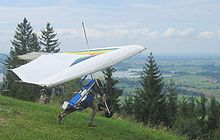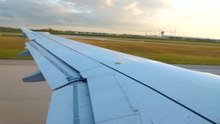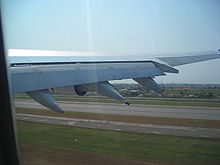Takeoff
![]()
This article or section is still missing the following important information:
see discussion page
Help Wikipedia by researching and adding them.
In aviation, takeoff or take-off is the beginning of an aircraft's flight from an airfield or other launch site - such as a helicopter launch site, a body of water, an aircraft carrier or a ramp. With take-off, the flying object begins to fly (airplanes, rotorcraft, hang gliders, etc.) or hover (airships, hot air balloons, gas balloons, etc.), depending on the type of construction or use. According to the ICAO definition of the term, "takeoff" extends from the setting of takeoff power (or beginning of taxiing for unpowered aircraft) until the aircraft reaches 35 feet (10.67 meters) above the ground or retracts its landing gear. Lift-off, not the entire take-off procedure, is an introductory flight maneuver for climb.
When lifting off, the object must overcome the weight force. Therefore, the lift force must be stronger than the weight force. The take-off method differs depending on the type of construction and payload. Most fixed-wing aircraft accelerate horizontally until they reach their lift-off speed. Exceptions are vertical take-offs and hybrids between rotorcraft and airplanes, such as flying helicopters or convertible airplanes. Helicopters and other rotary-wing aircraft generate the power to overcome the weight force with the aid of rotating rotor blades and therefore do not have to move horizontally during take-off. Rockets ignite liquid or solid fuels to generate recoil force to propel themselves.
In the case of aeroplanes and helicopters, this is called take-off, but in the case of balloons and airships, it is called ascent. In space travel, for example, a rocket is also referred to as a rocket launch.
.jpg)
An Airbus A310 on take-off

Lockheed C-130 of the Danish Air Force taking off on Vejers Strand
Launch Prep
In order to ensure a successful take-off, sometimes extensive preparations take place in advance. While in general aviation the pilot is usually left to manage these tasks on his own, in commercial aviation several organizational departments are involved.
The Aeronautical Meteorological Service provides information on weather at the point of departure, en-route weather and weather forecasts for the destination aerodrome and alternate aerodromes via personal consultation, telex transmissions, the Internet and the Automatic Terminal Information Service (ATIS). The aviation weather service also provides information on possible icing conditions. Icing conditions on the ground pose a hazard to take-off because ice on the wings significantly degrades aerodynamics and increases the take-off weight of the aircraft.
The de-icing service can remove snow and ice from the surfaces of the aircraft. De-icing agent is a mixture of water, alcohol (glycol) and additives. The surfaces can then be coated with a gel-like, alcoholic liquid that prevents the new build-up of ice or snow for a certain period of time. The minimum time available from the start of the surface treatment to the start is called hold over time (HOT). It is specified in tables and depends on the quality and concentration of the de-icing fluid, the outside temperature and the type of precipitation. Pilots must take care not to exceed the HOT. In case of an unforeseen delay before take-off, the de-icing procedure must be repeated.
Air traffic control (ATC) offices accept flight plans by telephone, in writing or by telex or via the Internet and issue departure restrictions, so-called slots, if traffic density so requires. Flight planning offices use an estimated take-off weight to calculate the most favourable flight route and flight altitude and the resulting fuel requirements.
All information relevant to the conduct of the flight concerning the operational readiness of aerodrome facilities, air navigation aids and other daily changing conditions such as construction activity in the vicinity of airports shall be passed on via ATC in the form of Notices To Air Men (NOTAM). Pilots are responsible for taking note of the information published in NOTAMs.
The technical status is usually documented in a logbook remaining on the aircraft, also called TechLog (short for technical logbook). If no entries are noted in it, the pilot can assume that all technical systems of the aircraft are functioning properly. If entries are made by pilots or maintenance personnel, it is up to the pilot to confirm the aircraft's operational clarity with his signature. To enable this decision to be made, aircraft manufacturers issue a list which lists the minimum technical requirements for the particular aircraft. This list is called the Minimum Equipment List (MEL) and must be recognized by the aviation authority of the operating state.
If a pilot or an aircraft maintainer finds a system to be faulty, he enters this fault into the TechLog. If the MEL allows the operation of the aircraft despite the error, the flight can be performed. The MEL is only relevant before take-off. Errors that occur after take-off are processed according to checklists, if possible. The problem-solving authority lies entirely with the pilot in flight; he can also make decisions without the approval of ATC. He may also be personally liable for criminal or economic consequences.
Before each flight, the pilot must perform a pre-flight check and satisfy himself of the airworthiness of the aircraft beyond the information in the TechLog. In general aviation, the aircraft manual determines the areas to be checked; in commercial aviation, binding checklists are used for this purpose.
If they concern engine start and movement of an aircraft, take-off procedures are closely communicated with air traffic control or aerodrome supervision. At controlled aerodromes, there are various air traffic control contacts. Usually, the (co)pilot first contacts the unit that activates the flight plan and issues the route clearance (clearance delivery), then the (co)pilot requests taxi clearance from the ground control unit (ground), from which the (co)pilot may be passed on to the de-icing service. The last point of contact on the ground is the tower, which issues the take-off clearance.

De-icing
Engineering
Ordinary aircraft need a runway on which they can accelerate to take-off (CTOL - Conventional Take-Off and Landing) or on which they can brake after touchdown when landing. Some aircraft have a particularly robust landing gear; this enables them to take off and land on natural runways.
Verticals, helicopters, balloons, rockets and airships use a take-off and landing site; they can take off and 'out-land' almost anywhere.
Aircraft
Ordinary aircraft take off from a runway and require a minimum speed relative to the surrounding air to take off. This is between 250 and 345 km/h for commercial aircraft, light aircraft need about 80 to 150 km/h, paragliders about 20 km/h, hang gliders 20 to 25 km/h. Aircraft roll on nitrogen-filled aircraft tires. The wheels only run or roll freely, i.e. they are not driven as in a motor vehicle, but can usually be braked by means of the wheel brakes. Paragliders and hang gliders must be accelerated to the necessary speed by foot during the usual running start.
Powered aircraft take off from horizontal by accelerating strongly by means of propeller or engine thrust. The take-off run must be in a straight line. Headwind is ideal and crosswind or tailwind unfavorable. Tailwinds restrict the ability to lift, crosswinds the ability to steer. Gliders are accelerated by external assistance (winches, rubber rope launch or powered aircraft). In seaplanes, skid-like floats are used instead of tyred undercarriages, which start to glide with little resistance during the take-off run in order to achieve the necessary take-off speed.
During the take-off run, many aircraft make full use of their engine power. If there is a calculable power surplus, the engine power of commercial aircraft can be reduced to a maximum of 25 % under full load in order to reduce the temperature of the engines and thus extend their service life. An increase in the angle of attack leads to an increase in aerodynamic lift on the wings, which means that above a certain speed the weight force is overcome and take-off is possible. At this point, the aircraft rotates around its lateral axis, which is caused by the change in elevator. The aircraft then lifts off and climbs to the planned altitude, where the climb ends and turns into cruising flight. Since the speed is still relatively low during takeoff, the flaps are extended somewhat to improve lift and avoid a stall. After take-off, the course is changed very frequently, since the runways rarely correspond to the direction in which the aircraft is to be steered.
The process of acceleration until rotation is called take-off run, it represents the first phase of the take-off. Before rotating, it is possible to abort the takeoff without going beyond the end of the runway.
To allow aircraft pilots to decide to abort or continue a takeoff when a problem occurs, a decision speed 

Shortly after take-off, the landing gear is retracted, if possible, to reduce air resistance. However, there are also types of aircraft whose landing gear cannot be retracted. There are numerous safety precautions during takeoff and landing; examples: Passengers must wear seat belts (protection in case of impact), tables in front of passengers' seats must be folded up, passengers' electrical and electronic devices must be switched off (interference), and smoking must be discontinued for fire safety reasons - generally prohibited in aircraft in Germany (reduction of ignition sources).
On many (not all) aircraft carriers, aircraft taking off are accelerated by an aircraft catapult in addition to their own engine. This allows particularly short runways, see take-off operations on an aircraft carrier.
Vertical takeoff
Vertical Take-Off and Landing (VTOL) aircraft take off vertically, and the rare tilt-wing aircraft are capable of both horizontal and hover take-off, giving them similar capabilities to a helicopter.
Helicopters and gyrocopters
Helicopters take off either from helicopter launch pads or from the ground, more rarely from bodies of water. The helicopter takes off when - after the main rotor(s) have been accelerated by the engines to the minimum necessary speed - the pitch angle of the main rotor blades is collectively increased by pulling the pitch lever and the resulting lift becomes greater than the mass of the helicopter. Normally, such a takeoff occurs with no relative speed to the ground. Helicopters with wheeled landing gear can also take off similar to a fixed-wing aircraft from a take-off run on a runway, this results in advantages with regard to the possible payload.
Gyrocopters start from the horizontal with a take-off run. In order to achieve the necessary initial speed of the free-running rotor, either rolling manoeuvres against the wind or the use of a prerotation device, alternatively immediately before the take-off run, are necessary, which ensure a minimum speed by means of an electric or hydraulic motor or by a mechanical shaft driven by the drive motor, before the rotor is passively accelerated to flight speed by the inflow of the airstream during the take-off run.
Airships
Airships take off from the anchor mast. They rise because their gas for lift has a lower density than the surrounding air.
Balloons
Balloons only require enough space to fill the balloon envelope for launch. With hot air balloons, the air in the balloon is heated to such an extent that the buoyancy of the air more than cancels out the weight of the balloon and gondola.
Personnel-carrying gas balloons take off by being lightened. This means that ballast is dropped. In a strong ground wind, four helpers sit on the edge of the basket and jump off simultaneously on command. This lightens the balloon abruptly, which prevents dangerous dragging on the launch field.
Rockets
→ Main article: Rocket launch
Missiles require a missile launch site on land or, rarely, on a submarine or missile ship. However, the launching of missiles in the military is very common from fighter aircraft (in flight). These missiles are mounted under the wings or under the fuselage. The rocket launcher is guided upwards or at an angle to the sky until the object flies by itself; this is called a rocket launch.
Ground-to-air missiles of the military can also be fired from trucks. Very small missiles such as the MILAN anti-tank missile or projectiles from anti-tank missiles can also be fired from a soldier's shoulder or from a mobile tripod. The majority of the missiles are fired via a launch pad for launching. Here, a countdown to lift-off is common.
Hang Glider
See also: "Start" in the article Hangglider
During a slope launch, the pilot of a hang glider must reach the necessary speed for a safe take-off. The slope helps him to do this. In order to facilitate the take-off run on uneven terrain, many flying sites have launch ramps.
Paragliders
In contrast to other flying machines, the paraglider gets its shape from the wind. The paraglider pilot lays it out on a meadow and then lets it rise like a kite. The paraglider fills with air and takes on the shape of a curved wing. Afterwards the glider stands steeply above the pilot. If there is enough wind, the pilot can hold the glider in this position for a longer time and control it with the brake lines. For the actual launch the pilot releases the brake lines and runs downhill. After a few steps he is lifted off the ground. For the launch you need a steep slope with enough treeless area on which the paraglider can be laid out. Paragliders can also be launched with a winch.

takeoff from a hang glider

MBB BK 117-B2 of the police NRW taking off
_Flight_Deck.JPG)
McDonnell Douglas F/A-18 at the catapult launch of USS Harry S. Truman (CVN-75)

A Boeing XB-47 Stratojet bomber takes off with launch vehicle support (U.S. Air Force)

Play media file Take-off of a passenger aircraft from Munich Airport

Flaps are extended during take off and point downwards
Search within the encyclopedia